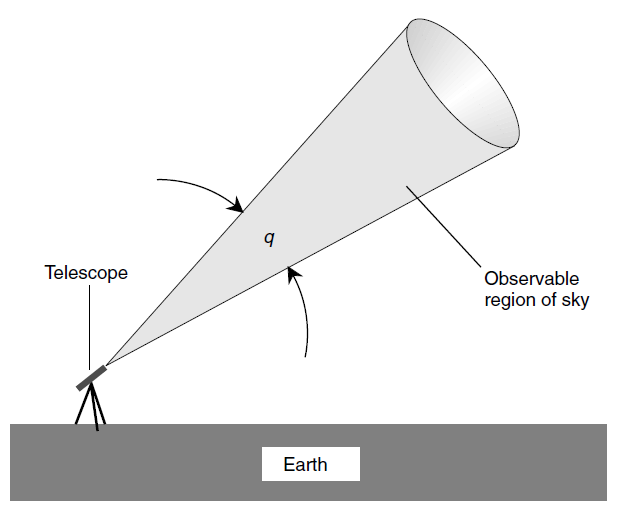
ABSOLUTE FIELD OF VIEW
 المؤلف:
S. Gibilisco
المؤلف:
S. Gibilisco
 المصدر:
Physics Demystified
المصدر:
Physics Demystified
 الجزء والصفحة:
518
الجزء والصفحة:
518
 10-11-2020
10-11-2020
 1861
1861
ABSOLUTE FIELD OF VIEW
When you look through the eyepiece of a telescope, you see a circular patch of sky. Actually, you can see anything within a cone-shaped region whose apex is at the telescope (Fig. 1). The absolute field of view is the angular diameter q of this cone; q can be specified in degrees, minutes, and/or seconds of arc. Sometimes the angular radius is specified instead of the angular diameter.
The absolute field of view depends on several factors. The magnification of the telescope is important. When all other factors are held constant, the absolute field of view is inversely proportional to the magnification. If you double the magnification, you cut the field in half; if you reduce the magnification to one-quarter of its previous value, you increase the field by a factor of 4.
The viewing angle—that is, the apparent field of view—provided by the eyepiece is important. Some types of eyepieces have a wide field, such as 60° or even 90°. Others have narrower apparent fields, in some cases less than 30°.
Another factor that affects the absolute field of view is the ratio of the objective diameter to its focal length. In general, the larger this ratio, the wider is the maximum absolute field of view that can be obtained with the telescope. Long, narrow telescopes have the smallest maximum absolute fields of view; short, fat ones have the widest maximum fields.

Fig. 1. A telescope’s absolute field of view q is measured in angular degrees, minutes, and/or seconds of arc.
 الاكثر قراءة في مواضيع عامة في علم البصريات
الاكثر قراءة في مواضيع عامة في علم البصريات
 اخر الاخبار
اخر الاخبار
اخبار العتبة العباسية المقدسة


